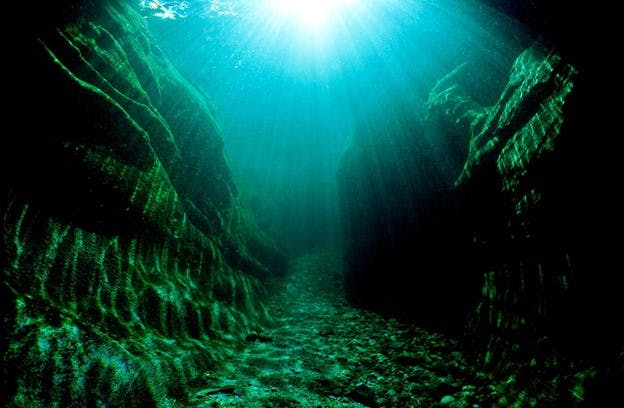March 2023
Let’s Take a Deep Dive Into Artesian Water
Water seems like it would be easy to understand. After all, you can see right through it. With just two hydrogen atoms, one oxygen, and the magic of chemistry, we get one of life’s most essential building blocks.
So if that’s all there is to it, why are there so many types of water? Step into your local corner store, and you’ll find countless varieties of H2O: alkaline, spring water, distilled, filtered, mineral water, sparkling water, and, if it's really fancy, artesian water.
Some of these are straightforward. For instance, filtered water is water that has been put through a filter. But others — like artesian water — may not be quite as easy to decipher.
If you see bottled water brands claiming to be natural artesian water at your grocery store, they will likely come at a premium. But besides the splashy name and the higher price tag, what is artesian water and what makes it different from all the other types of water you can buy?
In this article, we’ll explore what artesian water is, how it differs from other types of water, and help you decide whether it’s worth putting in extra time at the office to afford it.
What Is Artesian Water?
Artesian water is a type of spring water that originates from a water source called an artesian aquifer. The water can either be extracted through a drilled well or come up through the ground as a natural artesian spring. Usually, this water flows from deep under the Earth’s surface, but it doesn’t have to.
Artesian water starts as rain or groundwater, and it’s named more for the confined aquifer it comes from than for any special attributes of the water itself.
Where Does the Word “Artesian" Come From?
The word “artesian" comes from Artesium, the Roman name for the French region of Artois. During the Middle Ages, Artois was known for this type of well.
Unlike champagne, which must be made from grapes grown in the Champagne region of France to carry the name, artesian water can come from anywhere. Some of the biggest artesian aquifers in the world today are the Great Artesian Basin in Australia and the Edwards Aquifer in Texas.
What Is an Artesian Water Source?
There’s only one requirement for a water source to qualify as artesian: the water must come out of the ground under its own power. Underground aquifers are a major source of drinking water worldwide, but in most cases, we need to dig a well and pump the water out of the ground to get to it.
What makes an artesian water supply unique is that there is no pump needed. It’s instead pushed up out of the ground by what’s called artesian pressure, which we’ll explain below.
How Does an Artesian Water Well or Spring Work?
Most underground water sources are just flowing along through dirt, gravel, and permeable rocks. Digging a well to reach that water is like putting a straw in a cup. None of the water in the cup will rise to the top of the straw without an outside force.
On the other hand, artesian water aquifers have water trapped between layers of impermeable rock or thick sand. Source water above ground flows down into the ground until it gets trapped between layers of impermeable rock and sand. The weight of the water pushing against the floor, ceiling, and sides of the aquifer causes positive pressure.
If that natural pressure cracks through the top of the aquifer, the pressure pushes the water upward toward the surface, where it becomes artesian spring water.
Digging a well has a similar effect. Once the top is drilled into, the water releases upward toward the opening. If it flows over the top of the well, it’s known as a flowing artesian well. You can picture a flowing well like a geyser without all the heat and steam. And if it doesn’t quite make it to the top, it’s simply an artesian well. Either way, the water that comes up would now be considered artesian well water.
Unlike putting a straw in a glass of water, drilling an artesian well is more like stabbing through the foil seal of a juice box and unleashing a fountain.
Artesian wells and springs can produce intermittent or constant water, depending on the water source flowing into them.
Is Drinking Artesian Water Good for You?
Drinking water is generally good for the health of all life on Earth, but it's the content of the water we drink that matters. Unfortunately, most water is not pure because it picks up contaminants from its surroundings. These include naturally occurring and manmade substances, ranging from beneficial to deadly if ingested.
So what about artesian water?
Artesian water is groundwater. The layers of rock and soil groundwater passes through act as a water filtration system to clear out large particles and sediment. However, the water also picks up new contaminants along the way.
These can include:
- Minerals
- Synthetic chemicals and petroleum-based products
- Bacteria, parasites, or other microorganisms
- Radioactive material
- Microplastics
- Agriculture runoff
- Pharmaceuticals
- Animal waste
The artesian water that fills those fancy water bottles is often marketed as being packed with natural, beneficial minerals and electrolytes. These natural minerals, like calcium and magnesium, have some health benefits, but they’re not exclusive to artesian water. Most tap water has an abundance of these minerals because much of it is sourced from groundwater.
When you think about it this way, what is bottled artesian water aside from the same water that comes out of your tap but with a higher price tag?
Also, just because something comes from nature doesn’t mean it’s beneficial or without risk. For example, groundwater with sediment from volcanic rock can have unsafe concentrations of arsenic, which may cause arsenic poisoning and lead to the development of cancer and other diseases.
And mineral solids from groundwater sources turn tap water into hard water and make water softeners a popular household upgrade. Water softeners save your pipes, appliances, and surfaces from this damaging mineral build-up.
As far as the health benefits of artesian water are concerned, just like any other groundwater (or any water at all, really), it depends on what’s in it.
Is Bottled Artesian Water Safe To Drink?
All bottled water, including artesian water, sold in the United States is regulated by the U.S. Food and Drug Administration (FDA). By law, bottled water must meet the same safety standards as tap water. This means whenever the U.S. Environmental Protection Agency (EPA) updates the standards on your water company, the FDA follows with similar recommendations for bottled water.
So, if you consider tap water safe to drink, you should also consider artesian water safe to drink.
Similar to tap water, artesian water is pulled from the ground and then treated and filtered to remove harmful substances and meet the requirements of the FDA. The FDA gets its standards from the ones the EPA uses to protect your tap water.
However, some organizations, like the Environmental Working Group, say these standards are outdated. In fact, the EPA hasn’t updated regulations in almost 20 years.
Why Is Artesian Water So Expensive?
Products sell for what consumers are willing to pay for them. Artesian water is no different. So marketing departments in artesian water companies work hard to convince consumers that their product is superior even though it objectively isn’t any different from what their competition is selling.
Shopping smart can save you a lot on highly-priced bottled water, but you might even be able to get artesian water on tap. Many public water systems in the United States — like San Antonio, TX — get their water from artesian wells. The water is retrieved, treated in many of the same ways popular artesian brands like Fiji treat their water, and then sent to the consumer. The only difference is that one comes through a pipe at a fraction of the cost of what gets put in a plastic bottle and shipped across the world.
How Do I Know If My Tap Water Is Artesian Water?
If you live in the United States, your water company will put out an annual report known as either the Consumer Confidence Report or the Water Quality Report. This report should tell you where your water comes from.
You can call or check their website if you can’t find it there. If the report only identifies your water source as an aquifer, you may need to research that specific aquifer to find out if it’s artesian. Usually, a quick Google search with the name of the aquifer will answer your question pretty quickly.
You Can Get Great Tasting Water Without Paying Bottled Water Prices
The exotic marketing from artesian water companies might make you feel like you’re buying something special, but it's usually not worth the premium. We still think you deserve clean, great-tasting water, though.
HomeWater’s made-in-America products filter out chlorine, metals, rust, sediment, and many other flavor-altering compounds to leave you with just the clean water taste that nature intended.
Our 4-Stage Whole Home Water Filters are a cost-effective way to protect every faucet and fixture in your home. And you can add a salt-free water softener to protect your pipes and appliances from damaging hard water minerals.
If you want an easy-to-install alternative, check out our Undercounter 4-Stage Water Filter with reverse osmosis to protect your family from lead, microplastics, PFAS, microorganisms, fluoride, and more.



